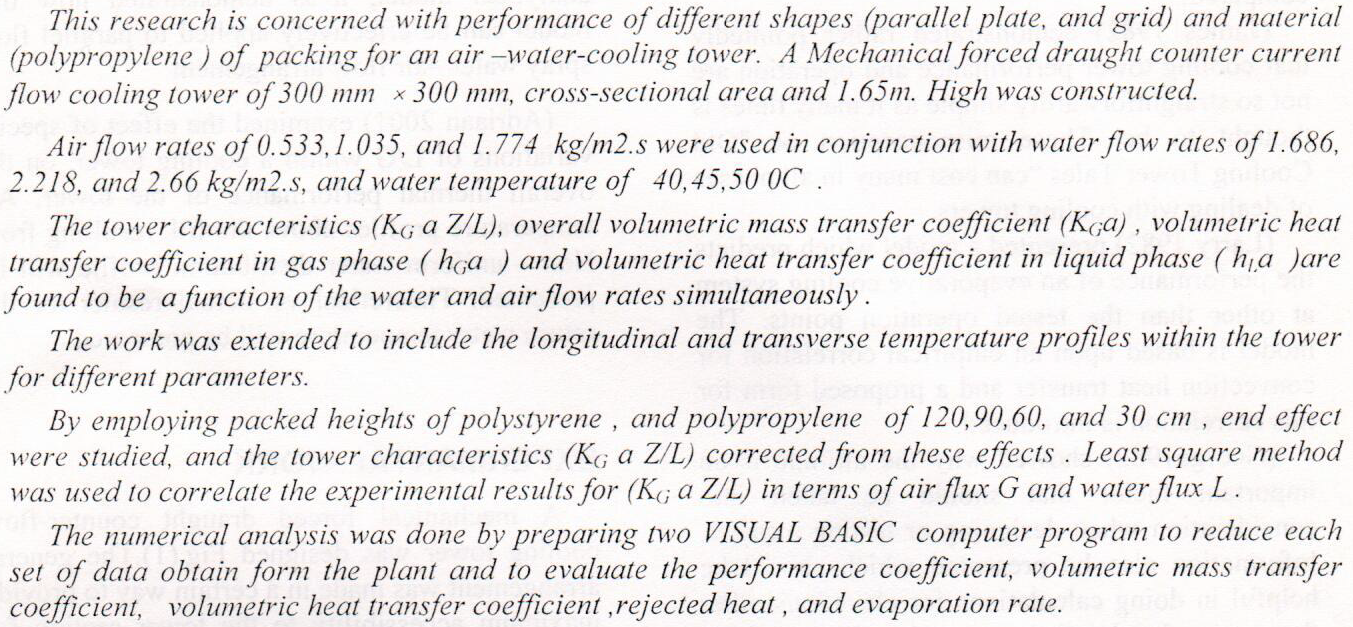
In this work, a numerical study is performed to predict the solution of two – dimensional, steady and laminar mixed convection flow over a square cylinder placed symmetrically in a vertical parallel plate. A finite difference method is employed to solve the governing differential equations, continuity, momentum, and energy equation balances. The solution is obtained for stream function, vorticity and temperature as dependent variables by iterative technique known as successive over relaxation. The flow and temperature patterns are obtained for Reynolds number and Grashof number at (Re= -50,50,100,-100) (positive or negative value refers to aidding or opposing buoyancy , +1 assisting flow, -1 opposing flow) and (102 to 105) , respective
... Show More (16)
(16)
 (13)
(13)
In this article, the nonlinear problem of Jeffery-Hamel flow has been solved analytically and numerically by using reliable iterative and numerical methods. The approximate solutions obtained by using the Daftardar-Jafari method namely (DJM), Temimi-Ansari method namely (TAM) and Banach contraction method namely (BCM). The obtained solutions are discussed numerically, in comparison with other numerical solutions obtained from the fourth order Runge-Kutta (RK4), Euler and previous analytic methods available in literature. In addition, the convergence of the proposed methods is given based on the Banach fixed point theorem. The results reveal that the presented methods are reliable, effective and applicable to solve other nonlinear problems.
... Show MoreTo maintain river flows necessary to meet social and ecological objectives, instream environmental flows are frequently used as a strategy. The capability of three alternative historical flow approaches to protect against low flows is shown in this study using gage stations in the Shatt Al-Hillah River in Iraq. The extension of the Shatt al-Hillah River is the focus of this research discussion on environmental flow assessment. The available data on discharge in this research were adopted for ten years from 2012-2021. Different flow methods were adopted to establish a minimum environmental flow in the Shatt Al-Hillah River. Three hydrological-based approaches: Tennant, modified Tennant, and low-flow metrics like 7Q10, wer
... Show MoreThe inhibitive action of polyvinyl alcohol –sodium nitrite (PVASN) composite on the corrosion of mild steel in simulated cooling water (SCW) has been investigated by weight loss and potentiodynamic polarization. The effect of composite concentration (PVA/SN) , pH, and exposure time on corrosion rate of mild steel were verified using 2 levels factorial design and surface response analysis through weight loss approach, while the electrochemical measurements were used to study the behavior of mild steel in (SCW) with pH between 6 and 8 and in absence and presence of (PVA) in solution containing different concentration of NaNO2. It was verified that all three main variables studied were statistically significant while their interaction is
... Show MoreThe electrochemical behavior of carbon steel in water sweetening station in Libya has been studied in the range of ( 293–333 oC) using weight loss technique. Measurements were carried out over a range of Reynolds number (5000 – 25000).An apparatus was designed for studying the corrosion process in the turbulent regime, which is of industrial significance. It was found that The corrosion rate of carbon steel in water sweetening station is under diffusion control and increases with increasing Reynolds number. On the other hand the variation of corrosion rate with temperature in the range of (293–333 oC) was found to follow Arrhenius equation and the activation energy approximately the same except at low Reynolds
... Show More (32)
(32)
The aim of this work is oriented to increase film cooling effectiveness value through numerical investigations for flow of Mach number not more than 0.3 around vane surface, to find the effects of inclination and compounds angles of round holes in staggered rows on adiabatic film cooling effectiveness of vane suction side. Multi cylindrical film cooling hole cases were studied with pitch ratio P/d =2 and 3, local blowing ratios M=0.382, 0.77 and 1.14, inclination angles a=30° and 45°, compound angles β= 0°, 15°, 30° and 45° and local momentum ratios I= 0.084, 0.34 and 0.756 for better cooling process.
A numerica
... Show MoreA new laboratory study conducted on stepped spillways in order to investigate their efficiency of dissipating flow energy. All previous study on stepped spillway indicated that the flow energy dissipation decreased as increasing in discharge. Increasing in the step numbers and the spillway slope led to energy dissipation decrease. In this study, an experimental attempt to increase energy dissipation at variable discharges was performed on stepped spillway and that leads to decreasing the cost of initiating the stilling basin or may be ignoring it. Five spillways were constructed from concrete and tested to investigate and compare among them. Three were roughed by gravel with different size for each one, one of them was s
... Show MoreIn this paper, analyzing the non-dimensional Magnesium-hydrodynamics problem Using nanoparticles in Jeffrey-Hamel flow (JHF) has been studied. The fundamental equations for this issue are reduced to a three-order ordinary differential equation. The current project investigated the effect of the angles between the plates, Reynolds number, nanoparticles volume fraction parameter, and magnetic number on the velocity distribution by using analytical technique known as a perturbation iteration scheme (PIS). The effect of these parameters is similar in the converging and diverging channels except magnetic number that it is different in the divergent channel. Furthermore, the resulting solutions with good convergence and high accuracy for the d
... Show More (2)
(2)
